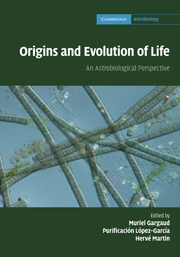Book contents
- Frontmatter
- Contents
- List of contributors
- Foreword
- Preface
- Part I What is life?
- Part II Astronomical and geophysical context of the emergence of life
- 6 Organic molecules in the interstellar medium
- 7 Cosmochemical evolution and the origin of life: insights from meteorites
- 8 Astronomical constraints on the emergence of life
- 9 Formation of habitable planets
- 10 The concept of the galactic habitable zone
- 11 The young Sun and its influence on planetary atmospheres
- 12 Climates of the Earth
- Part III The role of water in the emergence of life
- Part IV From non-living systems to life
- Part V Mechanisms for life evolution
- Part VI Life in extreme conditions
- Part VII Traces of life and biosignatures
- Part VIII Life elsewhere?
- Index
11 - The young Sun and its influence on planetary atmospheres
from Part II - Astronomical and geophysical context of the emergence of life
Published online by Cambridge University Press: 04 February 2011
- Frontmatter
- Contents
- List of contributors
- Foreword
- Preface
- Part I What is life?
- Part II Astronomical and geophysical context of the emergence of life
- 6 Organic molecules in the interstellar medium
- 7 Cosmochemical evolution and the origin of life: insights from meteorites
- 8 Astronomical constraints on the emergence of life
- 9 Formation of habitable planets
- 10 The concept of the galactic habitable zone
- 11 The young Sun and its influence on planetary atmospheres
- 12 Climates of the Earth
- Part III The role of water in the emergence of life
- Part IV From non-living systems to life
- Part V Mechanisms for life evolution
- Part VI Life in extreme conditions
- Part VII Traces of life and biosignatures
- Part VIII Life elsewhere?
- Index
Summary
The young Sun: activity and radiation
Magnetic activity in the young Sun
The Sun's magnetic activity has steadily declined throughout its main-sequence lifetime. This is an immediate consequence of the declining dynamo as a star spins down by losing angular momentum through its magnetized wind. Along with the decline in magnetic activity, solar radiation ultimately induced by the magnetic fields declined as well, and hence the short-wavelength radiative input into planetary atmospheres diminished with time. (By contrast, solar radiation at visible wavelengths increased with time, as discussed below.) Similarly, the magnetically guided solar wind and high-energy particle fluxes were very likely to be different in the young solar environment compared to present-day conditions. A closer understanding of the magnetic behaviour of the young Sun is therefore pivotal for further modelling of young planetary atmospheres, their chemistry, heating and erosion.
Magnetic activity expresses itself in a variety of features, including dark photospheric, magnetic spots, photospheric faculae and chromospheric plage producing optical and ultraviolet excess radiation, and – most dramatically – magnetically confined coronae containing million-degree plasma that emits extreme-ultraviolet and X-ray emission. Occasional magnetic instabilities (flares) and shocks both in the corona and in interplanetary space accelerate particles to energies much beyond 1 MeV; related electromagnetic radiation (e.g. from collisions) is emitted in the hard X-ray and gamma-ray range (Lin et al., 2002).
- Type
- Chapter
- Information
- Origins and Evolution of LifeAn Astrobiological Perspective, pp. 167 - 182Publisher: Cambridge University PressPrint publication year: 2011
- 2
- Cited by

